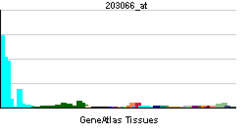GALNAC4S-6ST
Carbohydrate sulfotransferase 15 is an enzyme that in humans is encoded by the CHST15 gene.[3][4][5][6]
References
- ↑ "Human PubMed Reference:".
- ↑ "Mouse PubMed Reference:".
- ↑ Nagase T, Ishikawa K, Miyajima N, Tanaka A, Kotani H, Nomura N, Ohara O (Aug 1998). "Prediction of the coding sequences of unidentified human genes. IX. The complete sequences of 100 new cDNA clones from brain which can code for large proteins in vitro". DNA Res. 5 (1): 31–9. doi:10.1093/dnares/5.1.31. PMID 9628581.
- ↑ Verkoczy LK, Marsden PA, Berinstein NL (Oct 1998). "hBRAG, a novel B cell lineage cDNA encoding a type II transmembrane glycoprotein potentially involved in the regulation of recombination activating gene 1 (RAG1)". Eur J Immunol. 28 (9): 2839–53. doi:10.1002/(SICI)1521-4141(199809)28:09<2839::AID-IMMU2839>3.0.CO;2-6. PMID 9754571.
- ↑ Ohtake S, Ito Y, Fukuta M, Habuchi O (Nov 2001). "Human N-acetylgalactosamine 4-sulfate 6-O-sulfotransferase cDNA is related to human B cell recombination activating gene-associated gene". J Biol Chem. 276 (47): 43894–900. doi:10.1074/jbc.M104922200. PMID 11572857.
- ↑ "Entrez Gene: GALNAC4S-6ST B cell RAG associated protein".
Further reading
- Inoue H, Otsu K, Suzuki S, Nakanishi Y (1986). "Difference between N-acetylgalactosamine 4-sulfate 6-O-sulfotransferases from human serum and squid cartilage in specificity toward the terminal and interior portion of chondroitin sulfate.". J. Biol. Chem. 261 (10): 4470–5. PMID 3082866.
- Verkoczy LK, Guinn B, Berinstein NL (2000). "Characterization of the human B cell RAG-associated gene, hBRAG, as a B cell receptor signal-enhancing glycoprotein dimer that associates with phosphorylated proteins in resting B cells.". J. Biol. Chem. 275 (28): 20967–79. doi:10.1074/jbc.M001866200. PMID 10749872.
- Yuki M, Yoshinaga K, Yamakawa H, et al. (2000). "Structure, expression and mutational analysis of the hBRAG gene on 10q in the frequently deleted region in human endometrial cancer.". Oncol. Rep. 7 (6): 1339–42. doi:10.3892/or.7.6.1339. PMID 11032940.
- Sekiguchi T, Hirose E, Nakashima N, et al. (2001). "Novel G proteins, Rag C and Rag D, interact with GTP-binding proteins, Rag A and Rag B.". J. Biol. Chem. 276 (10): 7246–57. doi:10.1074/jbc.M004389200. PMID 11073942.
- Strausberg RL, Feingold EA, Grouse LH, et al. (2003). "Generation and initial analysis of more than 15,000 full-length human and mouse cDNA sequences". Proc. Natl. Acad. Sci. U.S.A. 99 (26): 16899–903. doi:10.1073/pnas.242603899. PMC 139241
 . PMID 12477932.
. PMID 12477932.
- Ohtake S, Kimata K, Habuchi O (2003). "A unique nonreducing terminal modification of chondroitin sulfate by N-acetylgalactosamine 4-sulfate 6-o-sulfotransferase". J. Biol. Chem. 278 (40): 38443–52. doi:10.1074/jbc.M306132200. PMID 12874280.
- Deloukas P, Earthrowl ME, Grafham DV, et al. (2004). "The DNA sequence and comparative analysis of human chromosome 10". Nature. 429 (6990): 375–81. doi:10.1038/nature02462. PMID 15164054.
- Gerhard DS, Wagner L, Feingold EA, et al. (2004). "The Status, Quality, and Expansion of the NIH Full-Length cDNA Project: The Mammalian Gene Collection (MGC)". Genome Res. 14 (10B): 2121–7. doi:10.1101/gr.2596504. PMC 528928
 . PMID 15489334.
. PMID 15489334.
- Sawada T, Fujii S, Nakano H, et al. (2005). "Synthesis of sulfated phenyl 2-acetamido-2-deoxy-D-galactopyranosides. 4-O-Sulfated phenyl 2-acetamido-2-deoxy-beta-D-galactopyranoside is a competitive acceptor that decreases sulfation of chondroitin sulfate by N-acetylgalactosamine 4-sulfate 6-O-sulfotransferase". Carbohydr. Res. 340 (12): 1983–96. doi:10.1016/j.carres.2005.06.010. PMID 16024005.

 . PMID 12477932.
. PMID 12477932. . PMID 15489334.
. PMID 15489334.